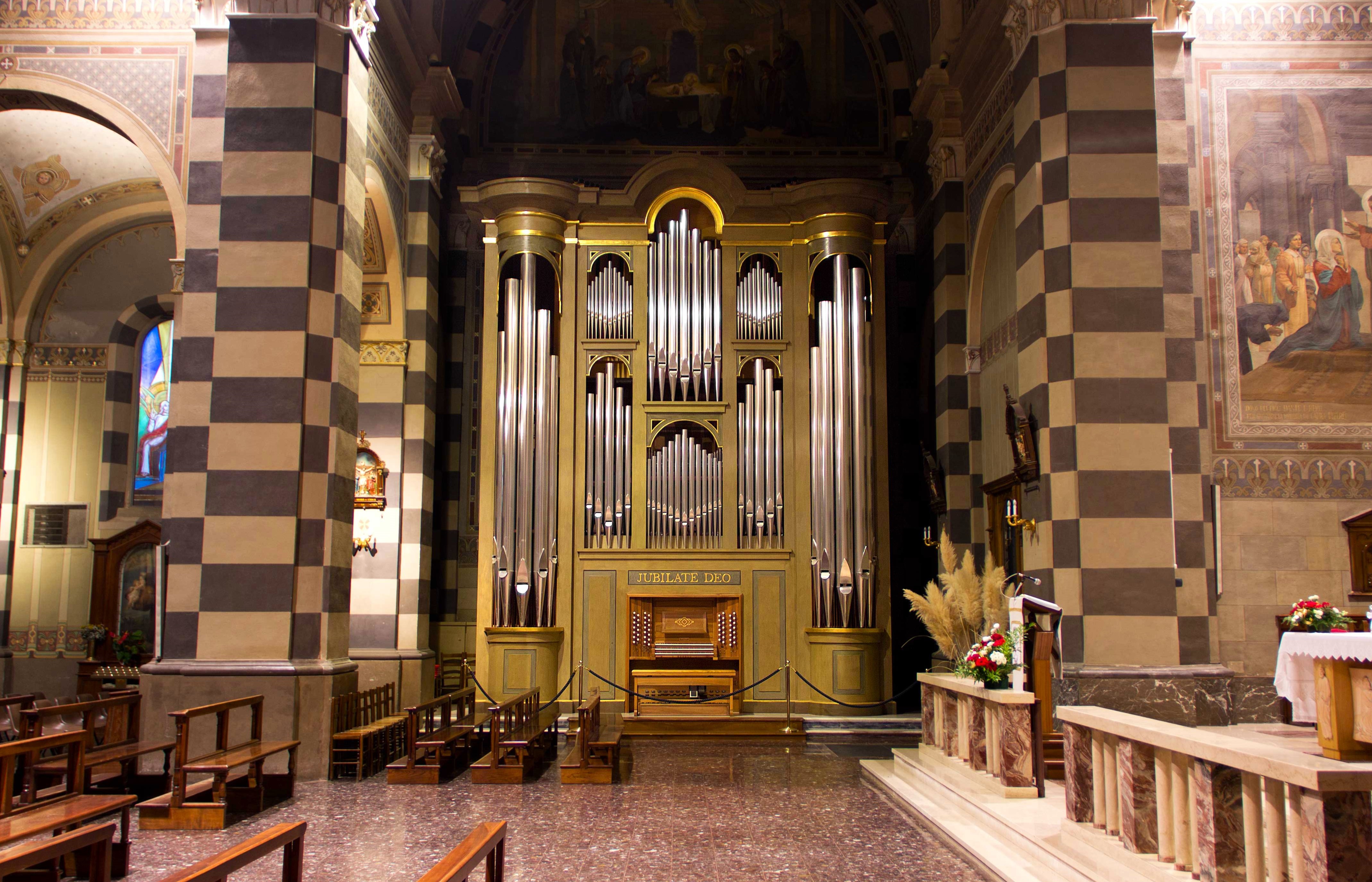Alessandria, Chiesa di San Giovanni Evangelista
| Builder | Mascioni |
|---|---|
| Year | ca. 2010 |
| Period/Style | Modern |
| Stops | 44 |
| Keyboards | 3+P |
| Keyaction | tracker/mechanical |
| Tuning | Equal at 440 Hz |
| Sampleset |
Available
 , sampled by
Piotr Grabowski
, sampled by
Piotr Grabowski
|
Alessandria is a city in the north-west part of Italy. It is located almost just in between 3 big cities: Milan, Turin and Genoa. The church of San Giovanni Evangelista originally was built in 1905, and was successively restored during the last few years.
Thanks to the efforts of the priest of the church, Don Claudio Moschini, the new organ was built in 2010 by the well known and appreciated company Mascioni. It is a 45 stop 3 manual organ consisting of 5 divisions: Grande Organo, Positivo, Recitativo espressivo, Pedale and Tuba. The tonal composition representing romantic-symphonic style was designed by M°Massimo Nosetti. One of the very interesting features is the Tuba 8′ stop, which is supplied by a separate blower. It’s a high pressure stop running at pressure of 400 mm, which is unique in Italy.
The keyboards have a range from C to c4 (61 notes) and the pedal from C to g1 (32 notes). Because of the organ’s thoughtful conception and colorful stoplist, it is widely seen as a very beautiful and versatile instrument by numerous organists. Several of them highlighted the particular qualities of the instrument and its acoustics.
Thanks to the efforts of the priest of the church, Don Claudio Moschini, the new organ was built in 2010 by the well known and appreciated company Mascioni. It is a 45 stop 3 manual organ consisting of 5 divisions: Grande Organo, Positivo, Recitativo espressivo, Pedale and Tuba. The tonal composition representing romantic-symphonic style was designed by M°Massimo Nosetti. One of the very interesting features is the Tuba 8′ stop, which is supplied by a separate blower. It’s a high pressure stop running at pressure of 400 mm, which is unique in Italy.
The keyboards have a range from C to c4 (61 notes) and the pedal from C to g1 (32 notes). Because of the organ’s thoughtful conception and colorful stoplist, it is widely seen as a very beautiful and versatile instrument by numerous organists. Several of them highlighted the particular qualities of the instrument and its acoustics.
| Grande Organo | Positivo | Recitativo Espressivo | Pedale |
|---|---|---|---|
| Principale 16' | Principale 8' | Controgamba 16' | Contrabasso 16' |
| Principale 8' | Flauto a camino 8' | Principale 8' | Subbasso 16' |
| Flauto doppio 8' | Ottava 4' | Corno di notte 8' | Quinta 10.2/3' |
| Gamba 8' | Flauto a cuspide 4' | Salicionale 8' | Basso 8' |
| Ottava 4' | Flauto in XII 2.2/3' | Voce Celeste 8' | Flauto 8' |
| Flauto 4' | Ottavina 2' | Flauto octaviante 4' | Corno 4' |
| Duodecima 2.2/3' | Terza 1.3/5' | Flautino 2' | Bombarda 16' |
| Quintadecima 2' | Cembalo 2 file 1' | Terziana 4 file 5.1/3' | Controfagotto 16' |
| Ripieno 4/6 file 1.1/3' | Cromorno 8' | Plein Jeu 3/5 file 2' | Fagotto 8' |
| Cornetto 5 file 8' | Tromba armonica 8' | Fagottino 4' | |
| Tromba 16' | Oboe 8' | ||
| Tromba 8' | Voix Humaine 8' | ||
| Campane |
https://piotrgrabowski.pl/alessandria/
 Pipe Organ Map
Pipe Organ Map



